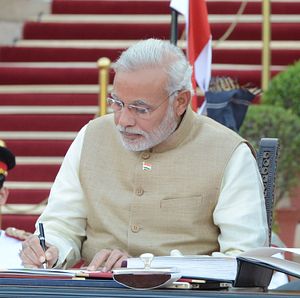The Narendra Modi government completes two years in office this month. Ever since the Bharatiya Janata Party-led (BJP) government came to power in May 2014, it has been dominated by the powerful personality of its prime minister. Today, Modi remains India’s most popular politician. He has benefited in many ways from the disarray in the ranks of the main opposition party, the Congress, that ruled India for the better part of the past six decades under the leadership of the Nehru-Gandhi family. Yet, the party today is struggling to retain its relevance in a rapidly changing nation, mainly because the dynasty is no longer as potent as it used to be.
If success can be measured by the shrinkage of the main opposition party, then the Modi government has clearly been successful in keeping Congress on the defensive by raking up a plethora of scams during its rule. Even as Congress’ presence in India is shrinking, under Modi, the BJP is expanding in parts of India where it could never set foot earlier. In the northeast and in the southern state of Kerala, for example, the BJP’s base has been expanding rapidly, turning it into a truly pan-India party.
On the economic front, India is the only economy standing among the much-touted BRICS, with estimates suggesting that the country has overtaken China as the world’s fastest growing economy. At a time when major global economies are shrinking against the backdrop of a strong U.S. dollar and falling commodity prices, India remains one of the few bright spots. Its economic growth is expected to reach 7.6 per cent this year, higher than the 7.2 per cent of 2014, when Modi took over. India also replaced China as the top destination for foreign investment (FDI) last year, largely on account of the push from the Modi government to increase manufacturing in the country. Yet, there has been disappointment in some quarters that the prime minister has not introduced any big-bang reforms as he seemed to promise during his election campaign.
Though the Modi government has failed to pass the Goods and Services Tax (GST) bill – that is to subsume all indirect taxes such as excise duty and service tax into a single standard rate – it has introduced several other measures that will have a long-term bearing on the economy. The insolvency and bankruptcy code, for instance, will make it easier to do business in India as it will ensure time-bound settlement of insolvency. It also makes it easier for the country’s financial sector to address loan recovery. Other initiatives include the direct benefit transfers scheme, which aims to transfer subsidies directly to the people through their bank accounts. It is hoped that crediting subsidies into bank accounts will reduce leakages and delays. There is a larger focus on governance by ensuring bureaucratic accountability that bodes well for the future. Because of the government’s tough stand on corruption, crony wealth in India has come down from 18 percent of GDP in 2008 to an estimated 3 percent this year.
On the foreign policy front, the government has been successful in leaving its unique imprint in a short period, making clear its objective of positioning India as a leading global player. Gone is the talk of non-alignment. Instead, the focus is on building strong partnerships with like-minded states to enhance India’s economic and diplomatic profile. From giving greater operational autonomy to the military in border areas to re-envisioning the country’s defense policy as an integral part of diplomacy, Indian strategic evolution has entered uncharted waters.
The country is now undertaking military exercises and defense interactions with like-minded states in Asia and beyond, including Japan, Vietnam, Australia and the United States—something that was considered to be controversial in the past in light of China’s reservations. New Delhi has decided to move ahead and deliver attack helicopter gunships to Kabul to buttress Indo-Afghan security ties. India is also wading into the South China Sea dispute between China and its neighbors by not only calling for freedom of navigation in international waters, but also agreeing to cooperate with the United States in safeguarding maritime security and ensuring freedom of navigation and overflight throughout the region, especially in the South China Sea. India’s Pakistan policy has also evolved to a point where New Delhi is now using Pakistan’s traditional allies in the Middle East, such as Saudi Arabia and the UAE, to put pressure on Islamabad to rein in militants.
Expectations for the Modi government are high and the Indian voter is highly aspirational. He wants delivery and that too fast. He is no longer as patient as it used to be. This is good news for Indian democracy, but it also means that Modi has his task cut out going forward.

































